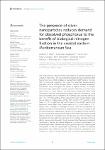The presence of silver nanoparticles reduces demand for dissolved phosphorus to the benefit of biological nitrogen fixation in the coastal eastern Mediterranean Sea
| dc.contributor.author | Rees, AP | |
| dc.contributor.author | Faraggiana, E | |
| dc.contributor.author | Tait, K | |
| dc.contributor.author | Celussi, M | |
| dc.contributor.author | Dafnomilli, E | |
| dc.contributor.author | Manna, V | |
| dc.contributor.author | Manning, A | |
| dc.contributor.author | Pitta, P | |
| dc.contributor.author | Tsiola, A | |
| dc.contributor.author | Živanović, S | |
| dc.date.accessioned | 2023-05-04T23:31:01Z | |
| dc.date.available | 2023-05-04T23:31:01Z | |
| dc.date.issued | 2022-09-21 | |
| dc.identifier.issn | 2296-7745 | |
| dc.identifier.issn | 2296-7745 | |
| dc.identifier.other | ARTN 907269 | |
| dc.identifier.uri | https://pearl.plymouth.ac.uk/handle/10026.1/20802 | |
| dc.description.abstract |
The release of silver into the marine environment is of growing concern as its impact on marine life is not fully understood. Despite previous experiments that have shown toxic effects of silver as nanoparticles (AgNPs) and as free ions (Ag+) on microbial organisms, the impact on important biogeochemical processes, such as marine nitrogen fixation, remains relatively unexplored. The present study investigated the impact of AgNPs and Ag+ on nitrogen fixation activity in oligotrophic coastal ecosystems. Nine mesocosm enclosures were set-up in Crete, Greece, for twelve days during May 2019. Three mesocosms were left unamended at ambient light and temperature; three were manipulated with 50 ng AgNPs L-1d-1 and three were amended with 50 ng Ag+ L-1d-1. Over the duration of the experiment, mean nitrogen fixation rates proved higher in treated waters; 0.28 ± 0.24 nmol N L-1d-1 and 0.21 ± 0.19 nmol N L-1d-1 in AgNP and Ag+ which were 2.2 (p< 0.001) and 1.6 (not significant) times higher than control rates of 0.13 ± 0.07 nmol N L-1d-1 respectively. Changes in nitrogen fixation rates were paralleled by significantly higher concentrations of phosphate and silicate in treated versus control mesocosms, suggesting an inhibition of the uptake of these nutrients by non-diazotrophic groups. Sequencing of 16S and 18S rRNA genes showed shifts in community composition over time but only very minor changes could be linked to the Ag treatments. Decreases to the relative abundance of three diatom species were observed in the Ag treatments but these were considered insufficient to support the relative differences in nutrient concentration. It is therefore speculated that there was physiological disruption of nutrient uptake mechanisms of the non-diazotrophic community. A number of potential diazotrophs were detected and the relative sequence abundance of a number of known nitrogen fixing taxa, including Burkholderiaceae, Oceanospirillales and Pseudomonadales correlated with measured nitrogen fixation rates. Phosphorus limitation of diazotrophic activity was therefore lowered relative to other microbial groups in silver amended treatments and significant increases in particulate nitrogen for both Ag treatments indicate an enhancement in cellular N for the nitrogen fixing communities. | |
| dc.format.extent | 907269- | |
| dc.publisher | Frontiers Media SA | |
| dc.subject | Diazotroph community | |
| dc.subject | Silver | |
| dc.subject | nanoparticle | |
| dc.subject | Mediterranean sea | |
| dc.subject | Phosphate | |
| dc.subject | Nitrogen Fixation | |
| dc.subject | Phosphorus | |
| dc.subject | alkaline phosphatase | |
| dc.title | The presence of silver nanoparticles reduces demand for dissolved phosphorus to the benefit of biological nitrogen fixation in the coastal eastern Mediterranean Sea | |
| dc.type | journal-article | |
| dc.type | Article | |
| plymouth.author-url | https://www.webofscience.com/api/gateway?GWVersion=2&SrcApp=PARTNER_APP&SrcAuth=LinksAMR&KeyUT=WOS:000864736200001&DestLinkType=FullRecord&DestApp=ALL_WOS&UsrCustomerID=11bb513d99f797142bcfeffcc58ea008 | |
| plymouth.volume | 9 | |
| plymouth.publication-status | Published online | |
| plymouth.journal | Frontiers in Marine Science | |
| dc.identifier.doi | 10.3389/fmars.2022.907269 | |
| plymouth.organisational-group | |Plymouth | |
| plymouth.organisational-group | |Plymouth|Research Groups | |
| plymouth.organisational-group | |Plymouth|Faculty of Science and Engineering | |
| plymouth.organisational-group | |Plymouth|Faculty of Science and Engineering|School of Biological and Marine Sciences | |
| plymouth.organisational-group | |Plymouth|Research Groups|Marine Institute | |
| plymouth.organisational-group | |Plymouth|REF 2021 Researchers by UoA | |
| plymouth.organisational-group | |Plymouth|Users by role | |
| plymouth.organisational-group | |Plymouth|Users by role|Academics | |
| plymouth.organisational-group | |Plymouth|REF 2021 Researchers by UoA|UoA07 Earth Systems and Environmental Sciences | |
| dcterms.dateAccepted | 2022-08-22 | |
| dc.date.updated | 2023-05-04T23:31:00Z | |
| dc.rights.embargodate | 2023-5-6 | |
| dc.identifier.eissn | 2296-7745 | |
| dc.rights.embargoperiod | forever | |
| rioxxterms.versionofrecord | 10.3389/fmars.2022.907269 |


